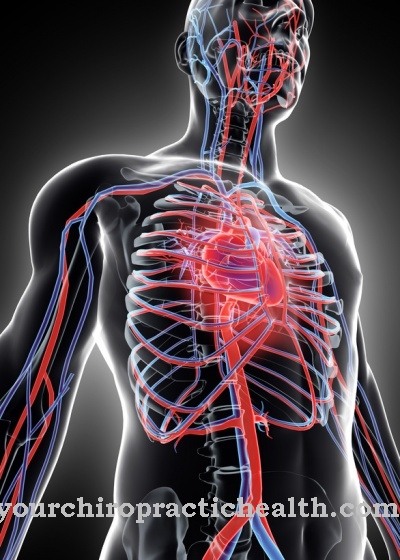As endoscopic transthoracic sympathectomy is a surgical procedure used to treat hyperhidrosis. This involves the severing of ganglia that belong to the sympathetic nervous system.
What is Endoscopic Transthoracic Sympathectomy?

Endoscopic transthoracic sympathectomy (ETS) is a minimally invasive surgical method that is used to treat excessive sweating (hyperhidrosis). Furthermore, peripheral circulatory disorders can be treated with this surgical procedure.
The sympathetic nervous system forms part of the autonomic nervous system. From him u. a. Signals sent to the blood vessels and sweat glands that are part of the peripheral circulation of the human body surface.
The origin of the responsible nerve fibers lies within small collections of nerve cells. These are called ganglia and are arranged along the spine. The sympathetic trunk is formed from the ganglion chain. Its course extends from the vertebral bodies on the neck to the lumbar spine.
By cutting the nerve nodes, it is possible to successfully treat certain forms of hyperhidrosis, which lead to excessive sweating. While in earlier times mainly major surgical interventions with corresponding operational risks were necessary for this purpose, nowadays the endoscopic transthoracic sympathectomy is considered the best surgical treatment method. It has now completely replaced the classic sympathectomy, which required a long stay in hospital.
Function, effect & goals
Endoscopic transthoracic sympathectomy is used primarily for severe hyperhidrosis of the face or hands for which other treatment methods are unsuccessful. ETS is one of the minimally invasive surgical procedures and is considered to be relatively low-risk.
The method has been steadily improved in recent years and in most cases has the effect of curing excessive sweats. Especially people who suffer from a combination of hand and foot sweat can also hope for an improvement in foot sweat through the operation. In contrast, endoscopic transthoracic sympathectomy is not suitable for treating isolated foot sweat. Its therapy must be carried out by a lumbar sympathectomy in the abdominal cavity.
With the endoscopic transthoracic sympathectomy, it is possible to access the ganglia in the chest cavity without major risks. The ganglia are responsible for secreting sweat on the face, hands and armpits. Particularly with armpit sweat, the surgical results are excellent. Almost all patients can be expected to improve their condition with the ETS.
At the beginning of the endoscopic transthoracic sympathectomy, the patient is given general anesthesia. So that no visible scars remain, the surgeon creates the access through a small skin incision in the armpit region. To insert the surgical endoscope, a small amount of carbon dioxide is also introduced into the patient's chest cavity beforehand. With the help of the special endoscope, which was specially developed for this surgical method, the doctor is able to identify the corresponding nerve ganglia.
These are cut or interrupted with high-frequency current. This is followed by sucking off the carbon dioxide. The wound is closed again with suture material that can be resorbed. The surgeon then performs the same procedure on the other side of the chest. The whole operation takes no more than 30 minutes on either side of the body. As a rule, the patient can leave the clinic after just a few days and resume his usual activities.
Since most doctors avoid operating on both sides of the chest in one day, two operations usually have to be performed several weeks apart. However, this has the disadvantage of two general anesthesia. The costs for the endoscopic transthoracic sympathectomy are usually covered by the statutory health insurance companies.
You can find your medication here
➔ Drugs against sweating and sweatingRisks, side effects & dangers
The risk of complications with ETS is considered to be relatively low. However, there may be inconveniences that lead to a longer hospital stay. Horner's syndrome is one of the greatest complications. This is caused by an injury to the stellate ganglion and often results in a one-sided asymmetry of the face. This leads to a drooping eyelid. However, by accurately identifying the ganglia, this problem can easily be avoided.
Another complication is the pneumothorax. This is caused by carbon dioxide residues or air between the chest wall and the lungs. Possible reasons are a minor lung injury or insufficient suction of the gas. If it is a small pneumothorax, no treatment is required as it will go away on its own after one or two days. If, on the other hand, there is a larger pneumothorax, which is seldom the case, it is suctioned off using a drain for one to two days. This complication can also usually be avoided by taking care when suctioning off the gas or introducing the medical instruments.
In some cases, the endoscopic transthoracic sympathectomy can be unsuccessful, but this is extremely rare for experienced doctors. Reasons for a failed operation include severe pre-existing diseases of the pleura, which means that access to the trunk is not possible. Anatomical deviations in the vessels that cover the ganglia are also possible causes.
As part of the ETS, undesirable side effects such as compensatory sweating can also occur. This shows an increasing secretion of sweat on the legs and trunk. This process occurs through physical exertion or heat. In some cases this shift in sweat production is very evident.












.jpg)



.jpg)










.jpg)
